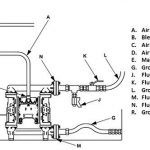To get the best performance from air pumps, they must be installed correctly. The 3 practical tips in this article will help you get maximum pump performance.
Tip 1: Check the inlet air line gauge and pressure
Pump supply air pressure plays a key role in getting the most out of the pump. Diaphragm pumps operate at a 1 to 1 ratio. This means that the air pressure supplying the pump motor is related to the fluid pressure at the pump outlet. Example: If the target pressure is 100 PSI the compressed air pressure must be at least 100 PSI.
The gauge of the pump supply piping is specified in the manufacturer's installation manual. As a general rule, it can be kept the same size as the pump inlet port. In this case, if the pump has a 1/2″ port, the hose gauge must be at least ½”
The most common mistake users make when installing an air pump is installing a compressed air line that is too narrow. To resolve this issue. Install the correct size of supply line and with a pressure regulator close to the pump.

Tip #2: Inspecting frostbite and damper restrictions
Dampers are recommended when operating diaphragm pumps as they reduce noise which can be quite annoying.
The pump's air motor requires compressed air to operate. However, when compressed air enters the air valve and channels through the pump to exhaust the damper at high speed, rapid temperature changes occur. In the exhaust of the muffler, the air temperature is below zero C° and can cause problems such as ice formation. This can reduce pump efficiency. Your air network has a high level of humidity.
One of the quick fixes to reduce ice formation is to lower the pump feed air pressure.
Here are additionally some suggestions to eliminate this problem:
- Increase pump size to operate at lower speeds
- Remove exhaust air to a distant location with an exhaust pipe
- Add an air line filter with a water trap and drain to collect condensation.
- Install an air line heater to increase the exhaust air temperature.
- Adjust the pressure dew point temperature with an air dryer.

Tip 3: Ensure proper tubing and tubing size
Here is some information the user should know about pump piping:
Pump fluid inlet and outlet tubing diameters vary based on the flow rate required for operation.
Inlet and outlet hose sizes must be the same as pump size
Example: If a 1 inch pump has a half inch inlet hose, the pump will not be able to operate at full capacity without the risk of cavitation.
This risk increases as the viscosity of the fluid increases. In this example, the 1-inch pump must have a 1-inch inlet and outlet hose to prevent cavitation.
It is also recommended that an air pump be installed with a flexible inlet and outlet hose. Rigid piping should be avoided. As pump speed increases, vibration increases, which can increase the risk of connections loosening and leakage as a result.

Always count on Duplacao, your trusted supplier for pneumatic pumps. Get in touch by phone (48) 3438-8484 or email vendas@duplacao.com.br and talk to our experts.










